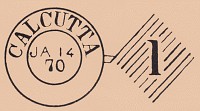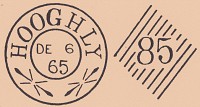
- SEARCH
-
Purchase CardCart
( 0 )
My Purchase Card
0 ITEMS IN YOUR BASKET

| Introduction | ||||
| PM 1 | PM 6 | PM 11 | PM 16 | PM 30 |
| PM 2 | PM 7 | PM 12 | PM 17 | PM 31 |
| PM 4 | PM 8 | PM 13 | PM 25-27 | PM 32-35 |
| PM B4 | PM 9 | PM 14 | PM 28 | PM 33 |
| PM 5 | PM 10 | PM 15 | PM 29 | PM Other |
Postmark Type 10
 Description – PM type 10 (JC-MN-SN) duplex double-ringed circular connected by two short parallel bars joining to right side diamond of 10 bars ascending left to right (Not to be confused with MP type 4a single PM thought to be error Bombay sub-region).
Description – PM type 10 (JC-MN-SN) duplex double-ringed circular connected by two short parallel bars joining to right side diamond of 10 bars ascending left to right (Not to be confused with MP type 4a single PM thought to be error Bombay sub-region). A recent important detailed study of this PM group was published India Post article (Vol. 52 2018) by Samik Nandi (SN), whom records various sub-types on this previously neglected area, built upon the research of Josef Braun, whom listed 21 sub-types, where Nandi lists twice as many! Astonishingly, neither Cooper, Martin, nor Renouf, ever delve into the variances encountered. Examples are predominantly found in various shades of blue ink, as is most frequent in Calcutta, but more generally found in Bengal than other postal sub-regions.
In use between 1862-73 according to Cooper (Martin (p.66) notes issued from 1862), within the postal sub-regions of Bengal, including Burma. Martin records numbers to the end of original series allocation up to 181 Toungoo Burma, plus a few beyond such as 220. Most Bengal numbers are common and Burma examples scarce.

Primarily the main subtypes listed by Nandi (2018) are:
Inland Mail
Type I – Early years India Unpaid with serifs 1862-4
Type II – Blue ink appears December 1864 – November 1865
Type III – Blue-black ink appears March 1866 – July 1866
Type IV ¬– Sans-serif font appears August 1865 – April 1866
Type V ¬– New design with florets Blue-black ink Sans-serif font without florets appears March 1867 – February 1871
Type VI ¬– New design serif fonts with letters B C or D left at foot between rings August 1871 – October 1871
Type VII ¬– Letters without serif font in blue-black ink January 1872 – June 1873
Foreign Mail
Type FI – Black India Unpaid with serif October 1862 – November 1863
Type FII – Blue-black India Unpaid with serif June 1864 – July 1872
Type FIII – Blue-black India Unpaid without serif
Type FIV – India Paid with serif October 1862 – 1863
Type FV – P.D with serif October 1862 – 1863?
This collection contained an example from Calcutta dating from 23rd December 1862 (Type F1), another Howrah 22nd November 1862 (Type F1), and many from 1863 including variation with hollowed ‘1’, encountered up to the 1873 period! Other examples are seen from non-Calcutta PO numbers with florets sent as foreign mail. An additional distinct PM ink shade seen is turquoise-green! A reddish ink instance (probably Calcutta '1') has been discovered by S. Das 2021.





